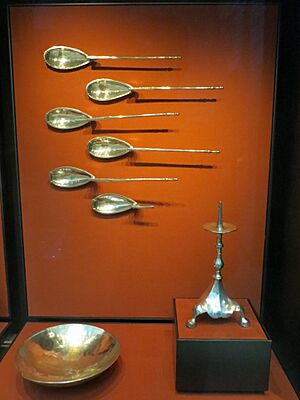Lampsacus facts for kids
|
Λάμψακος
|
|

Gold stater of Lampsacus, c. 360–340 BC, with the laurel-wreathed head of Zeus Lampsacus
|
|
| Alternative name | Pityusa, Pityussa, Lampsakos |
|---|---|
| Location | Lapseki, Çanakkale Province, Turkey |
| Region | Troad |
| Coordinates | 40°20′48″N 26°41′57″E / 40.34667°N 26.69917°E |
| Type | Settlement |
| History | |
| Builder | Colonists from Phocaea and Miletus |
Lampsacus was an ancient Greek city. It was located in a very important spot. This spot was on the eastern side of the Hellespont. The Hellespont is a narrow strait connecting the Aegean Sea to the Sea of Marmara. Lampsacus was in a region called the Troad. People from Lampsacus were called Lampsacenes. Today, a town called Lapseki is near its old location.
Contents
Early History of Lampsacus
Lampsacus was first known as Pityusa or Pityussa. People from the Greek cities of Phocaea and Miletus settled there. This means they started a new community.
Lampsacus Under Different Powers
In the 6th century BC, Lampsacus was attacked. Miltiades the Elder and Stesagoras led these attacks. They were rulers from a nearby area. Over time, Lampsacus was controlled by many different empires. These included Lydia, Persia, Athens, and Sparta.
The Persian king Darius I had rulers named Hippoclus and Acantides in Lampsacus. Later, another Persian king, Artaxerxes I, gave the city to Themistocles. The king wanted Lampsacus to provide its famous wine.
Wealth and Importance
Lampsacus was a very rich city. In 479 BC, it joined the Delian League. This was a group of Greek city-states led by Athens. Lampsacus paid a large amount of money, called a tribute. This showed how wealthy it was. In the 4th century, Lampsacus even made its own gold coins. Only the richest cities could do this.

In 411 BC, Lampsacus tried to rebel against Athens. But Athens quickly stopped the revolt. Later, in 196 BC, the Romans protected Lampsacus. They saved the city from Antiochus the Great. Because of this, Lampsacus became a friend of Rome. Writers like Cicero and Strabo said Lampsacus continued to do well under Roman rule. The city was also known for worshiping a god named Priapus. People believed he was born there.
Famous Thinkers and Leaders
The philosopher Anaxagoras moved to Lampsacus around 434 BC. He had faced a trial in Athens. The people of Lampsacus honored him greatly. They even built an altar to "Mind and Truth" for him. They also celebrated the day he died for many years.
Lampsacus had a tense moment with Alexander the Great. Alexander was very angry with the people of Lampsacus. He thought they supported Persia. He threatened to harm them greatly. So, they sent Anaximenes of Lampsacus to talk to him. Alexander swore he would do the opposite of whatever Anaximenes asked. Anaximenes was very clever. He said, "Please, your majesty, enslave the women and children of Lampsacus, burn their temples, and destroy the city!" Alexander was stuck. Because of his oath, he had to forgive the people of Lampsacus.
Many important historians and philosophers came from Lampsacus.
- Charon of Lampsacus (around 500 BC) wrote histories of Persia and other places.
- Metrodorus of Lampsacus (the elder) (5th century BC) was a philosopher.
- Strato of Lampsacus (around 335-269 BC) led Aristotle's school in Athens.
- Euaeon of Lampsacus was a student of Plato.
- A group of people from Lampsacus were friends with the philosopher Epicurus. This group included Polyaenus of Lampsacus, Idomeneus of Lampsacus, and Colotes.
- Anaximenes of Lampsacus was a famous speaker and historian.
The people of Lampsacus honored Anaximenes. They put up a statue of him at Olympia, Greece.
Christian History of Lampsacus
According to old stories, Saint Tryphon was buried in Lampsacus. This happened after he was killed for his faith in 250 AD.
The first known bishop in Lampsacus was Parthenius. He lived during the time of Constantine I. Lampsacus was part of a larger church area called Cyzicus. In 364, a bishop named Marcian was in charge. A meeting of bishops, called a council, was held in Lampsacus that same year.
Other bishops of Lampsacus included Daniel (451), Harmonius (458), and Constantine (680). John (787) and St. Euschemon were also bishops. St. Euschemon was known for defending the use of images in worship. The role of bishop in Lampsacus was mentioned in church records until about the 12th or 13th century. The famous Lampsacus Treasure, a collection of valuable items, comes from this time. It is now in the British Museum.
Today, the bishopric of Lampsacus is a titular see. This means it is a title given to a bishop, but there is no longer a real church community there.
See also
- List of ancient Greek cities
- List of traditional Greek place names
- Lampsace
- Anaximenes of Lampsacus
- Polyaenus of Lampsacus
- Metrodorus of Lampsacus (the younger)
- Abramios the Recluse



